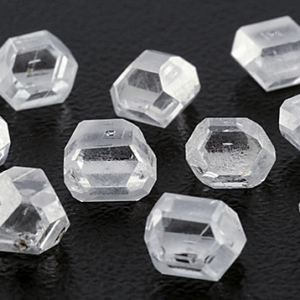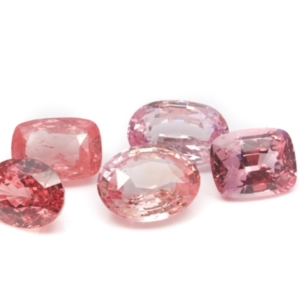Pierre Thomsonite – properties, virtues & benefits
Thomsonite stone is a rare and attractive variety of zeolite, which is prized for its pale Pink color and smooth texture. It is often used in jewelry and interior decoration to add a touch of softness and elegance. Discover the properties and uses of this unique stone.
THOMSONITE FEATURES
- Chakra: Heart.
- Properties: Soothing, calming, promotes empathy and communication.
- Astrology: Venus.
- Zodiac: Libra.
- Elements: Water, Air.
- Colors: Pale Pink, white, yellow.
- Hardness: 5 – 5.5 on the Mohs scale.
- Chemical Formula: NaCa2Al5Si5O20-6H2O.
- Associated god: /
PIERRE THOMSONITE – HIS HISTORY
In 1820, Henri James Brooke first described a stone that belongs to the silicate category, the zeolite group and the tectosilicate subgroup. Although named after Scottish mineralogist Thomas Thomson, its discovery is attributed to Brooke. This stone is generally milky in color, but can also have a Pink tint. It has a hardness of around 5.5 and is found mainly in hydrothermal and post-volcanic rocks. It is often compared to a nest of eggs and is considered almost organic in its spherical form. Firebirds nestling in volcanic rock are thought to be responsible for its creation, according to some legends. The specimens presented in this article come from Saogon in India, and this rare stone is highly prized by collectors and poets alike. Its chemical composition includes silica, aluminum, calcium and a small amount of sodium, which gives it a distinctive flavor.
THOMSONITE STONE – ITS ORIGIN AND COMPOSITION
Thomsonite stone is a rare mineral species in the zeolite family, first described by mineralogist Henri James Brooke in 1820. The stone is named after Scottish chemist Thomas Thomson, who helped classify its weight, grade and dimensions. Prior to 1997, Thomsonite was considered a mineral species, but the International Mineralogical Association changed its class to a series name, with the mineral species named thomsonite-Ca and thomsonite-Sr respectively. thomsonite-Ca, the more common of the two, is a hydrous aluminosilicate of sodium and calcium. Strontium can replace calcium, and the species name depends on the dominant element. The two species are visually indistinguishable, and when in doubt, the series name is used.
Thomsonite occurs mainly in volcanic areas, particularly in specific cavities in certain basaltic volcanic rocks. The main samples have been found on the island of Java, but it can also be found in many parts of the world, such as Scotland, Arkansas, Colorado, Michigan, Minnesota, New Jersey, Oregon, Ontario, Nova Scotia, India and Russia. The specimens presented in this article come from Saogon, India. Banded nodules are also found along the shores of Lake Superior. Nodule specimens are generally no larger than 0.6 cm, and those embedded in basalt are extremely difficult to extract without breaking. Consequently, a large proportion of those used as gems come from pebbles collected on beaches. Thomsonite has a hardness of around 5.5, making it relatively resistant to scratches and scuffs.
Thomsonite’s chemical composition includes silica, aluminum, calcium and a small amount of sodium, which gives it a distinctive flavor. This stone is highly prized by collectors and poets for its rarity and unique beauty. It is often described as almost organic in its spherical shape, reminiscent of an egg aggregate.

THOMSONITE STONE – VERTIES AND PROPERTIES
Thomsonite is a stone recognized in lithotherapy for its soothing and balancing properties. In Feng Shui, it is used to balance energies in a room and to improve communication between family members or work colleagues. This rare and precious stone is often appreciated for its unique shape and exceptional energetic qualities. It is recommended for those seeking to reduce stress and improve emotional and physical well-being, with both psychological and physical benefits. Warm and maternal, it creates a strong emotional bond with its wearer, offering protection and courage in many situations.
THOMSONITE ON THE PSYCHOLOGICAL LEVEL
Thomsonite is a stone known for its psychologically soothing properties, often used to help calm emotions and reduce stress and anxiety. It also helps increase self-confidence and self-esteem. This stone exudes a warm, maternal aura, offering great sensitivity and helPing to overcome nightmares and blockages. It can bring a sense of inner peace and security to help overcome fears and phobias. Thomsonite also enhances communication and strengthens emotional bonds, helPing to heal emotional traumas and wounds from the past by offering a positive outlook and optimistic vision of the future. During meditation, it can help improve concentration and mental clarity. In short, Thomsonite brings the inner balance and peace necessary for optimal psychological well-being.
PHYSICAL THOMSONITE
Thomsonite, a warm stone, also has interesting virtues and properties on the physical level. It is known to help regulate the digestive system by stimulating the liver and pancreas, as well as relieving joint and muscle pain by reducing inflammation. It is also beneficial for people suffering from addiction, as it supports them during withdrawal. As an energy-balancing stone, Thomsonite regulates blood pressure and reduces symptoms of hypertension. It also strengthens the immune system and relieves allergic symptoms such as eczema and hay fever. It improves blood circulation, reduces migraines and enhances sleep quality. These properties make it a useful stone for improving overall physical health.

PIERRE THOMSONITE – CLEAN AND RECHARGE
To clean and recharge Thomsonite stone, here are some methods you can use:
Cleaning:
- Distilled water: Gently rinse the stone under distilled water to eliminate impurities and accumulated negative energies.
- Salt: Place the Thomsonite stone in a bowl filled with non-iodized salt for a few hours. Be sure to rinse the stone well with water afterwards to remove any salt residue.
- Fumigation: use sage, palo santo or incense to smoke the stone and purify it.
Loading:
- Solar light: Place the Thomsonite stone under sunlight for a few hours to recharge it with solar energy.
- Moonlight: Place the stone under the light of the full moon overnight to recharge it with lunar energy.
- Quartz: Place the Thomsonite stone on a quartz cluster or quartz geode to recharge it with energy.
Choose the method that suits you best and respects the properties of Thomsonite stone.
WHERE DOES THE NAME THOMSONITE COME FROM?
The stone Thomsonite was named in honor of Scottish mineralogist Thomas Thomson, who was one of the first to describe the stone’s properties in 1835. Thomas Thomson was a renowned 19th-century chemist and mineralogist, who contributed to the advancement of science by identifying numerous minerals and develoPing new methods for studying them. Thomsonite was first described in the Kilpatrick Hills area, near Glasgow, Scotland, where Thomas Thomson carried out research and observations on the stone.
WHICH CHAKRA DOES THOMSONITE ACT ON?
Thomsonite acts primarily on the heart chakra, also known as Anahata in Sanskrit. This chakra is located in the center of the chest and is associated with love, compassion, harmony, inner peace and emotional healing. Thomsonite can help balance this chakra by stimulating positive emotions, boosting self-confidence and promoting harmonious relationships with others. It can also help heal emotional wounds and bring a sense of calm and well-being.
WHICH ASTROLOGICAL SIGN IS ASSOCIATED WITH THOMSONITE?
The astrological sign associated with Thomsonite is Libra. Libra is the seventh sign of the zodiac and is symbolized by a scale, representing balance and harmony. People born under the sign of Libra are often described as kind, balanced, sociable and artistic. Thomsonite can help Libra natives strengthen their sense of emotional balance, develop their ability to communicate and foster harmonious relationships with others.
THOMSONITE STONE SUMMARY
Thomsonite stone is a variety of zeolite, a mineral formed by the interaction of lava and seawater. It takes its name from Scottish geologist Thomas Thomson. Thomsonite is white, Pink, green or pale yellow in color, with a glassy surface and a pearly sheen. It is found mainly in India, Australia, New Zealand and the United States. Thomsonite is often used in jewelry, but is also used for water filtration and as a catalyst in chemical processes. It is also considered a healing and meditation stone, offering calming and soothing properties for the mind and body.

